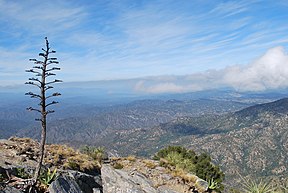
Sierra de San Pedro Mártir is a mountain range located within southern Ensenada Municipality and southern Baja California state, of northwestern Mexico.

The Peninsular Ranges are a group of mountain ranges that stretch 1,500 km (930 mi) from Southern California to the southern tip of the Baja California peninsula; they are part of the North American Pacific Coast Ranges, which run along the Pacific coast from Alaska to Mexico. Elevations range from 150 to 3,300 m.
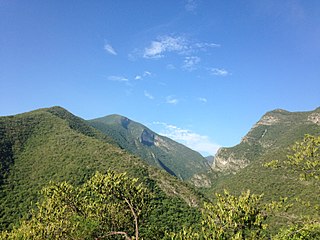
The Sierra Madre Oriental is a mountain range in northeastern Mexico. The Sierra Madre Oriental is part of the American Cordillera, a chain of mountain ranges (cordillera) that consists of an almost continuous sequence of mountain ranges that form the western "backbone" of North America, Central America, South America, and Antarctica.

The Sierra Madre del Sur is a mountain range in southern Mexico, extending 1,000 kilometres (620 mi) from southern Michoacán east through Guerrero, to the Isthmus of Tehuantepec in eastern Oaxaca.

The Baja California desert is a desert ecoregion of Mexico's Baja California peninsula. This ecoregion occupies the western portion of the Baja California peninsula, and occupies most of the Mexican states of Baja California Sur and Baja California. It covers 77,700 square kilometers. The climate is dry, but its proximity of the Pacific Ocean provides humidity and moderates the temperature. The flora mostly consists of xeric shrubs and over 500 species of recorded vascular plants.
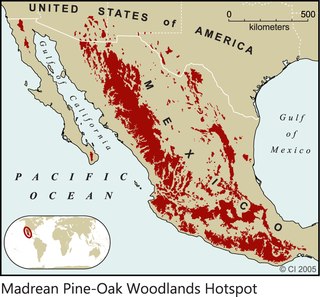
The Madrean pine–oak woodlands are subtropical woodlands found in the mountains of Mexico and the southwestern United States. They are a biogeographic region of the tropical and subtropical coniferous forests and temperate broadleaf and mixed forests biomes, located in North America.

The Sierra de Juárez, also known as the Sierra Juarez, is a mountain range located in Tecate Municipality and northern Ensenada Municipality, within the northern Baja California state of northwestern Mexico.
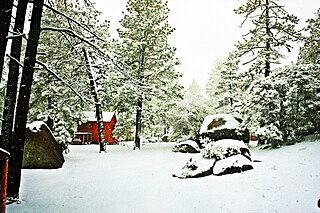
The Sierra Juárez and San Pedro Mártir pine–oak forests is a Nearctic temperate coniferous forests ecoregion that covers the higher elevations of the Sierra Juárez and Sierra San Pedro Mártir ranges of the Peninsular Ranges, of the northern Baja California Peninsula of Mexico. The pine–oak forests extend throughout the central portion of the Mexican state of Baja California and terminate near the border with the U.S. state of California.

The Sierra de la Laguna pine–oak forests are a subtropical coniferous forest ecoregion, found in the Sierra de la Laguna mountain range at the southern tip of the Baja California Peninsula, Mexico.

The Sierra de la Laguna dry forests are a subtropical dry forest ecoregion of the southern Baja California Peninsula in Mexico.

The Sierra Madre de Oaxaca pine–oak forests is a tropical and subtropical coniferous forests ecoregion in Southern Mexico.

The Sierra Madre Oriental pine–oak forests are a temperate broadleaf and mixed forest ecoregion of northeastern and Central Mexico, extending into the state of Texas in the United States.

The Trans-Mexican Volcanic Belt pine–oak forests is a subtropical coniferous forest ecoregion of the Trans-Mexican Volcanic Belt of central Mexico.

The San Lucan xeric scrub is a xeric shrubland ecoregion of the southernmost Baja California Peninsula, in Los Cabos Municipality and eastern La Paz Municipality of southern Baja California Sur state, Mexico.

The Balsas dry forests is a tropical dry broadleaf forest ecoregion located in western and central Mexico.
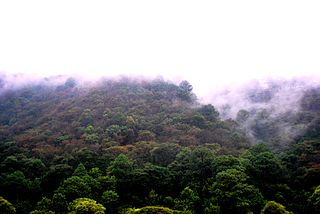
The Central American pine–oak forests is a tropical and subtropical coniferous forests ecoregion in the mountains of northern Central America and Chiapas state in southern Mexico.

The California coastal sage and chaparral is a Mediterranean forests, woodlands, and scrub ecoregion, defined by the World Wildlife Fund, located in southwestern California and northwestern Baja California (Mexico). It is part of the larger California chaparral and woodlands ecoregion. The ecoregion corresponds to the USDA Southern California ecoregion section 261B, and to the EPA Southern California/Northern Baja Coast ecoregion 8.
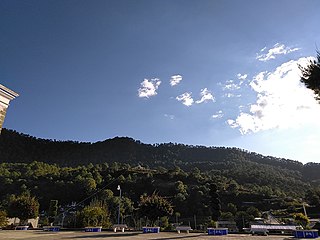
The Sierra Madre del Sur pine–oak forests is a subtropical coniferous forest ecoregion in the Sierra Madre del Sur mountain range of southern Mexico.

Nolina beldingii is a species of perennial flowering plant in the family Asparagaceae known commonly as the Cape nolina or Belding's beargrass. It is an arborescent monocot growing up to 7 metres (23 ft) high, with fissured bark on a trunk topped with leaf rosettes. The narrow leaves are up to 1.15 m (3.8 ft) long, and are used as thatching by local peoples. This species is endemic to Baja California Sur in Mexico, where it grows only in the highest reaches of the Sierra de la Laguna. It is found primarily in oak forests at elevations over 1,000 m (3,300 ft) along rocky granite outcrops.

Rumfordia connata is a species of flowering plant in the Millerieae tribe of the composite family commonly known as the Cape rumfordia. A conspicuous yellow-flowered shrubby perennial growing to 2 metres (6.6 ft) high, this species is endemic to the high elevations of the Sierra de la Laguna mountains of Baja California Sur where it is uncommonly found. Rumfordia connata was first discovered and later described by Townshend Stith Brandegee in 1892.
